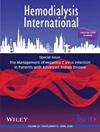Endogenous Bacterial Endophthalmitis Complicating Hemodialysis Catheter-Related Sepsis: A Case Report and Review of the Literature
Abstract
Background
Endogenous endophthalmitis is an infrequent yet severe complication of hemodialysis catheter-related sepsis. In this report, we present a case of endogenous bacterial endophthalmitis in a patient with hemodialysis catheter-related sepsis.
Case Presentation
A 65-year-old male had a history of hepatitis B-related glomerulonephritis, end-stage renal disease, hepatitis-B-related decompensated cirrhosis, hypertension, diabetes mellitus, and coronary artery disease. He received temporary central venous catheterization and commenced hemodialysis. Subsequent diagnosis of methicillin-resistant Staphylococcus aureus (MRSA) endogenous endophthalmitis originating from catheter-related bloodstream infection (CRBSI) was established. The patient underwent vitrectomy and received intravitreal antibiotic injections. Treatment with systemic and local antibiotics was sustained for a duration of 4 weeks, however, the patient's visual acuity remained poor.
Conclusions
Endogenous endophthalmitis represents a vision-threatening emergency necessitating rapid identification and intervention. Clinicians should maintain a high index of suspicion for endogenous endophthalmitis when ocular symptoms manifest in the context of sepsis. Timely ophthalmological evaluation and management are imperative to optimize patient outcomes.
Endogenous endophthalmitis represents a vision-threatening emergency necessitating rapid identification and intervention. Clinicians should maintain a high index of suspicion for endogenous endophthalmitis when ocular symptoms manifest in the context of sepsis. Timely ophthalmological evaluation and management are imperative to optimize patient outcomes.


 求助内容:
求助内容: 应助结果提醒方式:
应助结果提醒方式:


